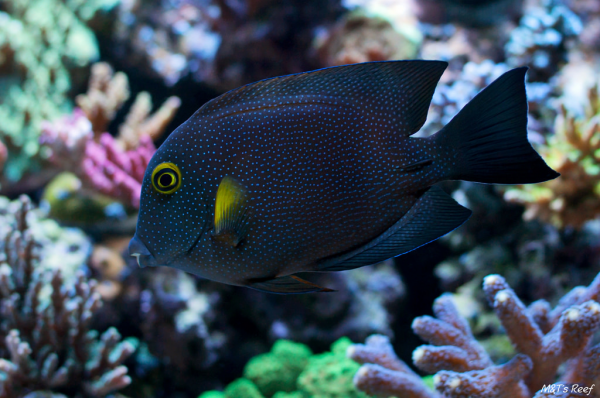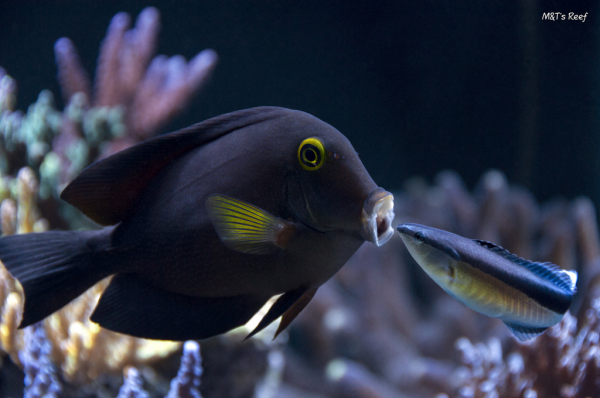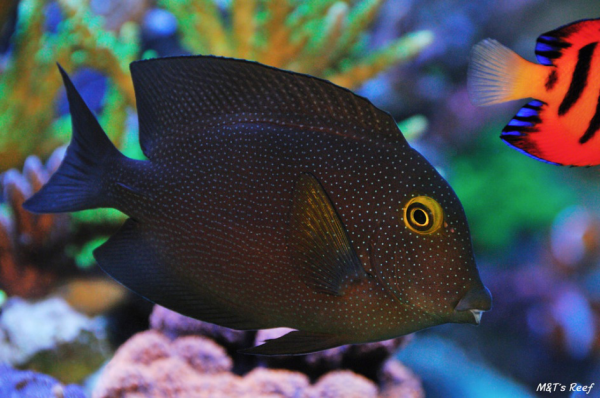I’m Seeing Spots Before My Eyes: The Indian Gold Ring Bristletooth Tang – Ctenochaetus Truncatus
The Indian Gold Ring Bristletooth Tang – Ctenochaetus truncatus
The Indian Gold Ring Bristletooth Tang (Ctenochaetus truncatus)is named for a short tail fin that does not have the elongated shape with pointed ends that is typical of other members of the genus. Other common names for this species are Spotted Bristletooth and Squaretail Bristletooth. C. truncatus is found throughout the Indian Ocean at depths from 1 to 21 meters (approx. 3 to 69 ft.) where they inhabit inner reef crests and slopes.
C. truncatus juveniles are quite striking with a bright yellow body that is covered with light spots. They are sometimes confused with their Pacific cousin, the Yellow Eye Kole Tang (C. striganus) as they are similar in color. As adults, both species sport a yellow eye ring and yellow dorsal fins, but the body of C. truncatus is covered in small, light blue spots, while C. striganus has small spots on the head area and light blue horizontal stripes on the rest of its body.
Although considered herbivores, surgeonfish of the Ctenochaetus genus (commonly referred to as Bristletooth Tangs) are detrivores. They have a protruding specialized mouth with several rows of flexible bristle or comb like teeth that are used to scrape, lift and sift detritus, diatoms, algae, and other organics from rocks, sand, and other surfaces.
Quick Stats
- Minimum Tank Size: 75 U.S. gallons (approx 285 liters)
- Care Level: Moderate
- Temperament: Semi-aggressive
- Reef Compatible: Yes
- Temperature: 70 to 79 F (21 to 26 C)
- Salinity: 1.020-1.026
- Maximum Size: Approx. 6.5 in.
- Diet: Herbivore
- Family: Acanthuridae
In the home aquarium, C. truncatus is best kept singly with peaceful tank mates. In larger tanks, they can be kept with other surgeonfish such as those from the Zebrasoma genus, but care should be taken when introduced. The use of an acclimation box, partition, or similar method is recommended, especially when larger or well-established surgeonfish are in the system. C. truncatus will do best long-term in an environment with plenty of rock and a sand substrate where they can graze throughout the day. They will readily eat most prepared aquarium foods and should be offered dried seaweed (tied to a rock or on a clip) three times per week, meaty foods such as mysis and enriched brine shrimp, as well as herbivore preparations containing spirulina.
While most hobbyists opt for the more commonly available Yellow Eye Kole Tang, C. truncatus can be an excellent choice for the modern reef aquarium. They are handsome, hardworking, and active fish that can provide both enjoyment and utility for your home reef.
References
www.fishbase.org/summary/Ctenochaetus-truncatus.html
Fenner, Robert, 2015, Surgeonfishes: Tangs For Marine Aquariums: Diversity, Selection & Care, WetWebMedia 153pp
Author
Terry Lauderdale is . . .




Leave a Reply
You must be logged in to post a comment.